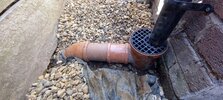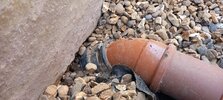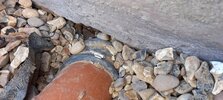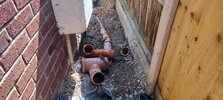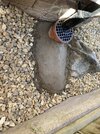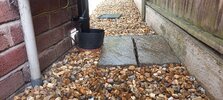I had the old clay drains replaced down one side of my house and the company I hired used plastic ones to replace them. The drains carry rain water from the gutters into the combined sewer. The new plastic gullies each connect to a length of plastic pipe which link to the outlets (at property boundary) with a rubber fastener that has been tightened around what remained of the clay pipes within my boundary.
There's a bit of a long story behind this which also involved running a drain pipe from the front garden to the back garden to help with run off, and that drain runs down the same side of the house. It would've been preferable to leave the old clay roof drains as they were in my opinion, they appeared rock solid, but the company destroyed them and replaced with the new plastic ones. Anyway, that's water under the bridge, or down the drain...
What I noticed after the job was finished is that one of the new gullies is only one brick below DPC. The outlet at the boundary is set high, only just below the gravel board of the boundary fence which is part of the problem, nevertheless, the original clay one was two bricks below DPC using a P trap. The type of trap they've used to replace it is different so that the little grid the gutter drains to is now higher than was previously the case.
My concern is that this could be flagged on a future survey if I try to sell the house as being contrary to building regs. The proximity of the plastic pipe to the surface is also a concern, bearing in mind the old one was caked in concrete. The company put mortar over the top of it to give some protection and I have subsequently created a flag stone "bridge" so it doesn't get stood on. It is at narrow side of the house which isn't a main access, but this may also concern future buyers.
When I've tried to discuss with the company they've been dismissive and now won't communicate. Question to you wise men: does the work they've done look ok? Is this likely to cause me problems in future? What would you do, if anything?
I attach some photos.
There's a bit of a long story behind this which also involved running a drain pipe from the front garden to the back garden to help with run off, and that drain runs down the same side of the house. It would've been preferable to leave the old clay roof drains as they were in my opinion, they appeared rock solid, but the company destroyed them and replaced with the new plastic ones. Anyway, that's water under the bridge, or down the drain...
What I noticed after the job was finished is that one of the new gullies is only one brick below DPC. The outlet at the boundary is set high, only just below the gravel board of the boundary fence which is part of the problem, nevertheless, the original clay one was two bricks below DPC using a P trap. The type of trap they've used to replace it is different so that the little grid the gutter drains to is now higher than was previously the case.
My concern is that this could be flagged on a future survey if I try to sell the house as being contrary to building regs. The proximity of the plastic pipe to the surface is also a concern, bearing in mind the old one was caked in concrete. The company put mortar over the top of it to give some protection and I have subsequently created a flag stone "bridge" so it doesn't get stood on. It is at narrow side of the house which isn't a main access, but this may also concern future buyers.
When I've tried to discuss with the company they've been dismissive and now won't communicate. Question to you wise men: does the work they've done look ok? Is this likely to cause me problems in future? What would you do, if anything?
I attach some photos.


